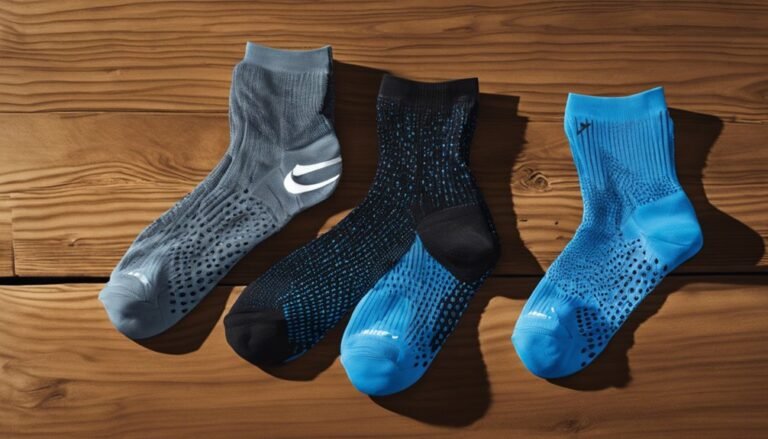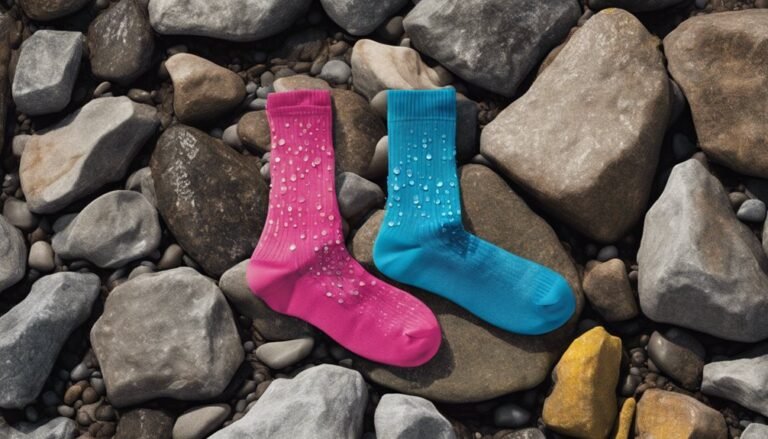Cold Weather Running Socks vs. Regular Running Socks
Cold weather running socks differ greatly from regular running socks in their design and features. They prioritize insulation, moisture management, and protection against cold elements, making them essential for comfort during winter runs. In contrast, regular socks focus on breathability and responsiveness. Cold weather options often use thermal materials and compression for a snug fit, preventing cold feet and blisters. For insights on selecting the right pair, you'll find valuable details that can enhance your running experience.
Understanding the Purpose of Running Socks

When you lace up your shoes for a run, the type of socks you choose can greatly impact your performance and comfort. Understanding the purpose of running socks is essential to maximize your running benefits. There are various sock types, including lightweight, cushioned, and moisture-wicking options, each designed to address specific needs. Lightweight socks help maintain breathability, while cushioned varieties offer additional comfort for longer distances. Moisture-wicking materials keep your feet dry, reducing the risk of blisters. Choosing the right sock type can improve your gait and prevent injuries, enhancing your overall running experience. By making informed decisions on sock selection, you empower yourself to enjoy the freedom of running without unnecessary discomfort or distractions.
Key Features of Regular Running Socks
Regular running socks are designed with specific features that cater to the unique demands of runners. One key aspect is sock thickness; it varies to provide ideal comfort and performance. Thinner socks offer a more minimalist feel, enhancing ground contact and responsiveness, while thicker options can provide additional warmth and cushioning. Speaking of cushioning levels, regular running socks often include targeted padding in high-impact areas, which helps absorb shock and reduce fatigue during long runs. These features work together to promote breathability and moisture-wicking, keeping your feet dry and comfortable. Ultimately, choosing the right sock thickness and cushioning level can greatly impact your running experience, allowing you to focus on your performance without unnecessary distractions.
Essential Attributes of Cold Weather Running Socks
When choosing cold weather running socks, insulation and warmth are essential to keep your feet comfortable in low temperatures. Additionally, moisture management technologies play an important role in preventing sweat buildup, which can lead to discomfort and cold feet. Understanding these fundamental attributes can enhance your running experience in chilly conditions.
Insulation and Warmth
Although you might not think about it often, the insulation and warmth provided by cold weather running socks are essential for maintaining comfort and performance during winter workouts. Unlike regular socks, these specialized socks utilize thermal layering and advanced materials designed for peak heat retention. This guarantees your feet stay warm without overheating, allowing for a more enjoyable running experience in chilly conditions.
Key benefits of cold weather running socks include:
- Enhanced thermal insulation to trap body heat
- Moisture-wicking properties to manage sweat
- Strategic cushioning for added comfort
- Longer lengths to protect against cold air exposure
Moisture Management Technologies
Moisture management is a critical aspect of cold weather running socks, as it directly impacts your comfort and performance. Effective moisture barriers are designed to wick away sweat, preventing it from pooling and chilling your feet. This is essential for maintaining temperature regulation, especially in frigid conditions. By utilizing advanced synthetic materials, these socks guarantee that moisture is transported away from your skin, keeping you dry and warm. Additionally, some socks incorporate special technologies that promote breathability, allowing for air circulation without sacrificing insulation. Ultimately, investing in socks with superior moisture management not only enhances your running experience but also helps you maintain peak foot health during those cold weather runs.
Material Differences: What to Look For
When choosing socks for cold weather running, you'll want to pay close attention to the materials used, as they greatly impact performance. Insulation properties, moisture-wicking capabilities, and breathability are essential factors that can enhance your comfort and keep your feet dry. Understanding these differences will help you make an informed decision for your winter runs.
Insulation Properties Comparison
To effectively combat the chill of cold weather, understanding the insulation properties of running socks is essential. Different insulation types can notably impact your comfort and performance. When choosing cold weather running socks, consider the following:
- Material Composition: Look for blends that include wool or synthetic fibers for better insulation.
- Thickness: Thicker socks often provide more warmth but may affect fit.
- Temperature Regulation: Verify the socks can regulate heat without causing overheating.
- Seam Construction: Flat seams can help eliminate pressure points and enhance comfort.
These factors contribute to effective insulation and temperature regulation, allowing you to maintain warmth while enjoying your run. Don't underestimate the importance of selecting the right socks for cold weather conditions.
Moisture-Wicking Capabilities
While cold weather can make running challenging, choosing socks with effective moisture-wicking capabilities is essential for maintaining comfort and performance. Moisture control plays a vital role in temperature regulation, ensuring your feet stay dry and warm during your run. When selecting cold weather running socks, focus on materials designed to pull moisture away from your skin and promote faster evaporation.
| Material | Moisture-Wicking Ability |
|---|---|
| Merino Wool | Excellent |
| Synthetic Fibers | Good |
| Cotton | Poor |
| Bamboo | Good |
| Blends | Variable |
Breathability in Cold Weather
Moisture-wicking capabilities are important, but breathability is another key factor to evaluate when choosing cold weather running socks. The right material can greatly enhance your running experience by providing breathability benefits that promote temperature regulation. When selecting socks, consider the following:
- Fabric Type: Look for merino wool or synthetic blends that allow airflow.
- Weave Structure: A looser knit can improve ventilation while maintaining warmth.
- Moisture Management: Verify that materials effectively wick away sweat to prevent dampness.
- Fit and Design: Choose socks with mesh panels or strategic cushioning for enhanced airflow.
Fit and Comfort: Finding the Right Sock

How do you know if your running socks provide the right fit and comfort for cold weather? First, consider sock sizing; a snug fit is essential to prevent bunching and blisters during your runs. You don't want them too tight, as that can restrict circulation. Next, think about your foot arch. If you have high arches, look for socks with added support and cushioning to enhance comfort. For those with flat feet, a more compressive fit may be beneficial. Additionally, guarantee the material wicks moisture while maintaining insulation. Ultimately, finding the right sock means balancing these factors to keep your feet warm, dry, and comfortable, allowing you the freedom to enjoy your cold weather runs without distraction.
Tips for Choosing the Best Running Socks for Cold Weather
Finding the right fit and comfort in running socks sets a solid foundation, but when it comes to cold weather, there are additional factors to contemplate. To guarantee your feet stay warm and dry during chilly runs, consider the following tips:
- Choose moisture-wicking materials to enhance temperature regulation.
- Explore sock layering techniques; a thin base layer can provide warmth without bulk.
- Look for cushioned options to protect against cold surfaces.
- Pay attention to sock height; taller socks can offer extra warmth and coverage.
Frequently Asked Questions
Can I Wear Regular Running Socks in Cold Weather?
You can wear regular running socks in cold weather, but their materials might not provide ideal temperature regulation. For better comfort and warmth, consider socks designed specifically for cold conditions to enhance your running experience.
How Often Should I Replace My Running Socks?
You should replace your running socks every 300 to 500 miles. The sock lifespan varies based on sock materials; synthetic blends often last longer than cotton. Regular checks for wear can help maintain ideal comfort and performance.
Are Thicker Socks Always Better for Cold Weather?
Thicker socks aren't always superior; it's like choosing a warm blanket versus a breathable one. Consider sock materials that balance warmth with moisture-wicking properties, ensuring your feet stay dry and comfortable during chilly runs.
Can Running Socks Prevent Blisters in Cold Conditions?
Running socks can indeed aid in blister prevention during cold weather by minimizing friction and enhancing moisture-wicking. Choosing the right materials and fit is essential to keep your feet comfortable and protected while running.
Do Cold Weather Socks Impact Running Performance?
Like a well-tuned engine, cold weather socks can enhance your running performance. Their insulation properties and moisture management keep your feet warm and dry, allowing you to maintain comfort and focus during colder runs.







